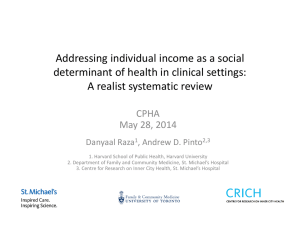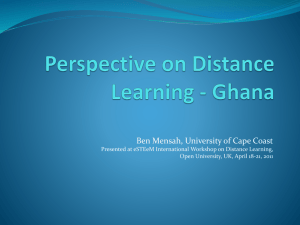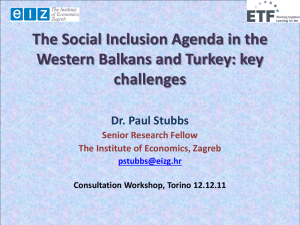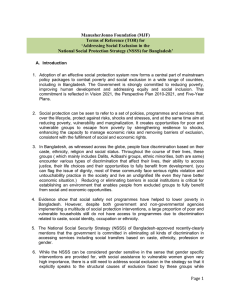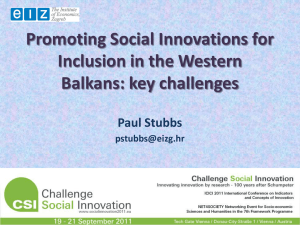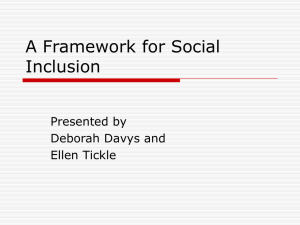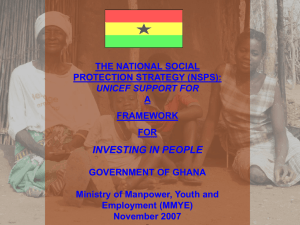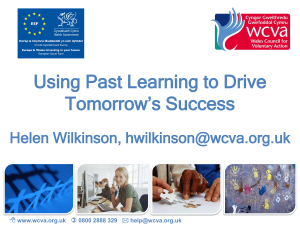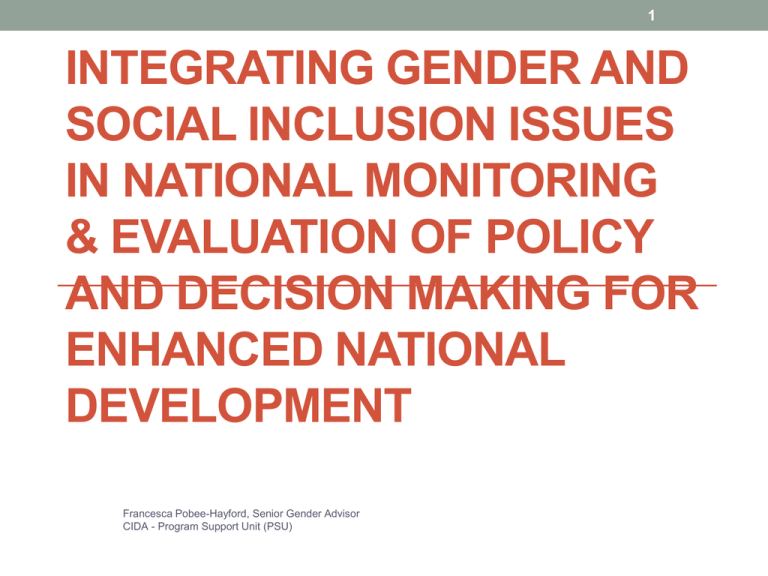
1
INTEGRATING GENDER AND
SOCIAL INCLUSION ISSUES
IN NATIONAL MONITORING
& EVALUATION OF POLICY
AND DECISION MAKING FOR
ENHANCED NATIONAL
DEVELOPMENT
Francesca Pobee-Hayford, Senior Gender Advisor
CIDA - Program Support Unit (PSU)
2
OUTLINE
• Gender Equality (GE)
• Some GE Issues, Policies and Programmes in Ghana
• Social Exclusion (SE) and Social Inclusion (SI)
• Some SI Issues, Policies and Programmes in Ghana
• How they have been Monitored and Evaluated in Programmes for
Evidenced Based Decision Making and Policy Formulation
• What Could Be Improved
• GE and SI Implications for National Development
• Conclusion
3
GENDER
Strategy used in Ghana - Gender Mainstreaming
It is a strategy for making women’s as well
as men’s concerns and experiences an
integral dimension of the design,
implementation, monitoring and
evaluation of policies and programmes in
all political, economic and social spheres
so that women and men benefit equally and
inequality is not perpetuated.
4
5
GENDER
Approach - two pronged usually adopted
Women specific and gender and development policies and
programmes GAD –
Focus has been on men and women and unequal gender
relations;
The goal has been on empowerment, emancipation and equality;
the strategy has been to achieve sustainable development e.g.
women and girls rights,
their access to and control over resources and benefits and
participation in decision making
6
SOME GE POLICIES/PROGRAMMES
• Implementation of Domestic Violence National Policy and
Plan of Action (NPPA)
• Bridging the gender gap in access to education – girl
friendly schools, female teacher role models, no
tolerance for sexual harassment etc.
• Economic empowerment programs for women – business
support services, access to credit etc.
• Monitor gender mainstreaming and gender responsive
budgeting across sectors
7
SOME GE POLICIES/PROGRAMMES
• Affirmative action policy guidelines and programs
for increasing women’s participation in decision
making
• Maternal health programs
• Provision of safe, portable and affordable water
8
SOCIAL EXCLUSION
• Social exclusion (SE) is the
outcome of multiple
deprivations that prevent
individuals or groups of people
from participating fully in the
economic, social, and political life
of the society in which they live.
9
SOCIAL INCLUSION
• Social inclusion (SI) is achieved
when ALL (i.e. including
excluded individuals or groups of
people) have the necessary
opportunities and resources to
participate fully in economic, social,
cultural and political activities which
are considered the societal norm
10
11
WHO ARE THE SOCIALLY
EXCLUDED?
Some Examples
• People living below the poverty line ‘poor’
• Some Children, Aged or Elderly
• Majority of People Living with Disabilities
• Majority of People living with HIV/AIDS
• Majority of Marginalized Tribal groups
• People branded as witches, wizards etc
• Some women, widows, widowers, orphans etc.
12
HOW TO ADDRESS SE ISSUES
Design and implement policies and programs to address
issue of limited access to
Financial Capital – earnings, wealth, income sharing etc.
Human Capital – education, skills, credentials, recognition
Social Capital – family, friends, community life, political
empowerment or ‘voicelessness’
Physical Capital – housing, infrastructure and geographical
location
13
SOME NATIONAL INCLUSION
POLICIES /PROGRMS
• Scaling up of Livelihood Empowerment Against Poverty
(LEAP)
• Scaling up National Health Insurance Scheme (NHIS)
registration for the indigent
• Improve access to quality education for People with
Disability (PWD).
• School feeding programs, free uniforms and text books
14
IMPLEMENTATION - CHALLENGES
• Policy/program implementation have not always
been informed by a good GE or SI analysis
• Implementation has not always been consistent,
some times ad hoc, no focus on all components
of policy/programs
• Resources for implementation have been limited
and not consistent
15
HOW MONITORED & EVALUATED?
• Activity reports, (format lack basic ingredients e.g.
checklists) e.g. LEAP
• Quarterly reports (collation difficulties) - e.g. LEAP
• Annual reports (same as above) – e.g. GLSS, DHS,
MICS
• Evaluations or
• Impact assessments have been rare e.g. LEAP
16
LIMITATIONS
• Policies and programs for the most part has been based on
weak baselines or no baselines
• Some have been conceived without the appropriate
supporting monitoring and evaluation frameworks
• Overall M & E capacity weak even more so for GE and SI
• Lack of/poor GE and SI components as part of overall M & E
frameworks/plans at all levels – now being established by
NDPC
17
LIMITATIONS
• Linkages between GE and SI programs, projects,
activities and outputs has been weak
• Linkages between GE/SI outputs, outcomes has been
weak
• Linkages to a performance management framework
indicating baselines, targets, performance indicators,
means of verifications, data sources and responsible
agencies etc. has been weak
18
LIMITATIONS
• Inadequate budgetary allocations for M & E
• Limited or non existence of periodic evaluations
• Impact assessments – no follow through of
recommendations
• Participatory M & E including implicated
beneficiaries i.e. – women and disadvantaged
groups, not a common feature
19
WHAT COULD BE IMPROVED
• GE/SI analysis informed by the collection and
analysis of disaggregated (age, sex, locality –i.e.
urban and rural) data is critical
• Other social statistical information on exclusion e.g.
PWD, aged, PLWHA etc.
• Policy formulation and program design based on the
above and sound statistical analysis
• A clear M & E plan to monitor and evaluate SI/GE
with emhasis on the following
20
WHAT COULD BE IMPROVED
• A proper evidence based decision making
framework clearly linking activities, outputs with
outcomes
• Linkages to a Performance Management Framework
(PMF) indicating baselines, targets and performance
indicators, means of verifications, data sources and
responsible agencies etc.
• Making M and E participatory to enhance ownership
• Periodic evaluations and impact assessments
21
SOME BENEFITS OF GE
• Equalizing access to agric inputs would increase output
by 2-4%
• Eliminating employment segregation would increase
productivity by 3-25%
• Women’s control of household earnings changes
spending in favour of children
• Educated women invest more in children thereby
enhancing human capital for national development.
Source: World Development Report, 2012
22
IMPLICATIONS OF GE FOR NATIONAL
DEVELOPMENT
• Enhanced human capacity for national
development.
• Closing earnings and productivity gaps between
men and women.
• Increasing women’s voice in decision making.
• Limiting gender inequality across generations.
Source: World Development Report, 2012
23
COST OF SOCIAL EXCLUSION
• Loss of potential human capital for
national development
• Inter generational poverty
• Can potentially lead to social upheaval
and crime
24
IMPLICATIONS OF SI FOR NATIONAL
DEVELOPMENT
• Promotes their independence and livelihoods
• Enhanced human capacity for national development
• Closing earnings and productivity gaps between the
advantaged and disadvantaged
• Increasing their voice in decision making
• Protects the poor from worst destitution and from
destitution when faced with an economic shock and limits
social exclusion across generations
25
26
CONCLUSION
• As a Middle Income Country (MIC)
there is the need to improve M & E
of GE and SI programmes and
policies among others to
demonstrate commitment towards
moving toward a more egalitarian
society.
27
Thank you.


